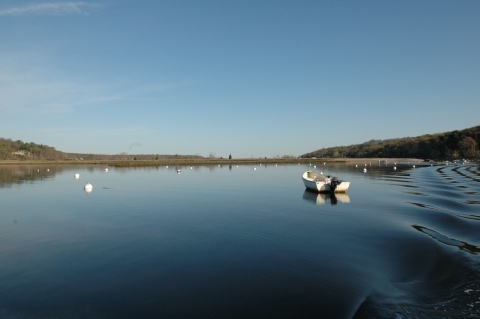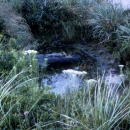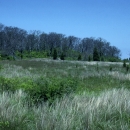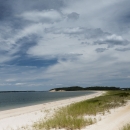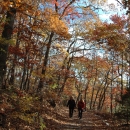About Us
The Congressman Lester Wolff Oyster Bay National Wildlife Refuge was donated to the Service by the Town of Oyster Bay in 1968 as a habitat for migratory birds, particularly wintering waterfowl. The refuge is unique in the System, serving as a marine refuge rather than the more traditional terrestrial refuge; it comprises the waters and marshes of Oyster Bay and Cold Spring harbors. This refuge is open to the public.
The refuge is located on the north shore of Long Island in eastern Nassau County. This 3,209-acre refuge includes subtidal (bay bottom to mean high tide line) habitats, saltmarsh and a freshwater pond. The refuge is the largest refuge in the Long Island National Wildlife Refuge Complex and receives the most public use of all the refuges. The state of New York designated this refuge as a significant coastal fish and wildlife habitat. The refuge is especially important for wintering waterfowl such as black ducks, greater scaup, bufflehead, canvasback and long-tailed ducks. A variety of other waterbirds including shorebirds, terns and cormorants also use the refuge. Other marine organisms common to the refuge include northern diamondback terrapins, harbor seals, sea turtles, finfish and shellfish. Management activities include wetland restoration and protection of the natural shoreline and vegetation. Fishing (Town of Oyster Bay permits required for shell fishing), wildlife observation, photography and environmental education are approved recreational uses on the refuge.
Aquatic Habitats
Congressman Lester Wolff Oyster Bay National Wildlife Refuge consists of 3,204 acres of bay bottom, salt marsh salt marsh
Salt marshes are found in tidal areas near the coast, where freshwater mixes with saltwater.
Learn more about salt marsh , and a small freshwater wetland. It is managed principally for use by migratory waterfowl and other waterbirds. It is also one of the few bay-bottom refuges owned and managed by the U.S. Fish and Wildlife Service. The refuge is located off Long Island Sound, and the sheltered nature of the bay makes it extremely attractive as winter habitat for a variety of waterfowl species, especially diving ducks.
The State of New York has designated the Oyster Bay area as a Significant Coastal Fish and Wildlife Habitat. Marine wildlife common to the refuge includes harbor seals, diamondback terrapins, and several species of sea turtles. Shellfish and finfish are abundant at Oyster Bay. The bay supports the only commercial oyster farm aquaculture operation remaining on Long Island, and an estimated 90 percent of the commercial oysters in New York originate from areas associated with the refuge.
Our Mission
Vision
Long Island National Wildlife Refuge Complex will preserve, manage, and restore some of the last significant natural areas for wildlife habitat, ranging from coastal systems, to native grasslands to mature forests. These habitats, present in nine distinct units, will support threatened and endangered species in addition to hundreds of species of migratory birds and other wildlife within the Atlantic Flyway.
Located adjacent to the nation’s major media center, the Complex is an ideal setting to increase public awareness, understanding and support of the National Wildlife Refuge System. We recognize that success is dependent on the Complex becoming an integral part of the community. We will work together with partners and local communities to protect priority wildlife-dependent recreational and educational opportunities. Through the use of the best scientific information and active habitat management, we will contribute to the fulfilling of the mission of the National Wildlife Refuge System for future generations.
Refuge Purpose
Each unit of the National Wildlife Refuge System is established to serve a statutory purpose that targets the conservation of native species dependent on its lands and waters. All activities on those acres are reviewed for compatibility with this statutory purpose.
The purpose of Congressman Lester Wolff Oyster Bay National Wildlife Refuge is as follows:
- “…for use as an inviolate sanctuary, or for any other management purpose, for migratory birds” (16 U.S.C. §715d).
Our History
Established in 1968, Oyster Bay was a donation from the town of Oyster Bay under the authority of the Migratory Bird Act. The refuge's water and marshes surround Sagamore Hill National Historic Site, which was the home of father of the National Wildlife Refuge System: Theodore Roosevelt. Oyster Bay also contains the last remaining oyster farm in New York State which produces 90% of the state's oyster harvest.
From Oyster Bay to Congressman Lester Wolf Oyster Bay
As of January 31st, 2020, Oyster Bay National Wildlife Refuge had been renamed as Congressman Lester Wolf Oyster Bay National Wildlife Refuge. Not only was Congressman Lester Wolf a primary contributor to the refuge's creation in 1968, but spent most of his career protecting the refuge along with a variety of natural resources on Long Island. One of his most notable accomplishments was leading the opposition to the construction of a 8.5 mile bridge across Oyster Bay in the late 1960s, thus preserving the Bay's natural beauty and integrity. Congressman Lester Wolf's legacy and the natural treasures he secured for Long Island will now live on through the refuge, as he passed as of May 11th, 2021 at 102 years old.
Other Facilities in this Complex
The Long Island National Wildlife Refuge Complex consists of seven national wildlife refuges, two refuge sub-units and one wildlife management area wildlife management area
For practical purposes, a wildlife management area is synonymous with a national wildlife refuge or a game preserve. There are nine wildlife management areas and one game preserve in the National Wildlife Refuge System.
Learn more about wildlife management area . Collectively, the ten units are approximately 6,500 acres in size. Each unit is unique and provides a wildlife oasis amongst Long Island’s urban settings essential for the livelihood of migratory birds, threatened and endangered species, fish and other wildlife. The strategic location of Long Island in the Long Island Pine Barrens & along the Atlantic Flyway make it an important nesting, wintering and migratory stop over area for hundreds of species of birds.




